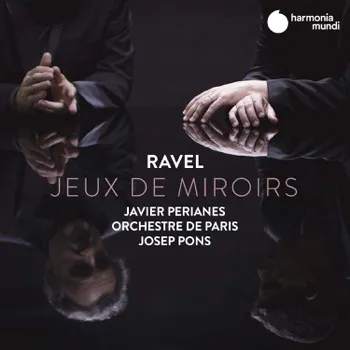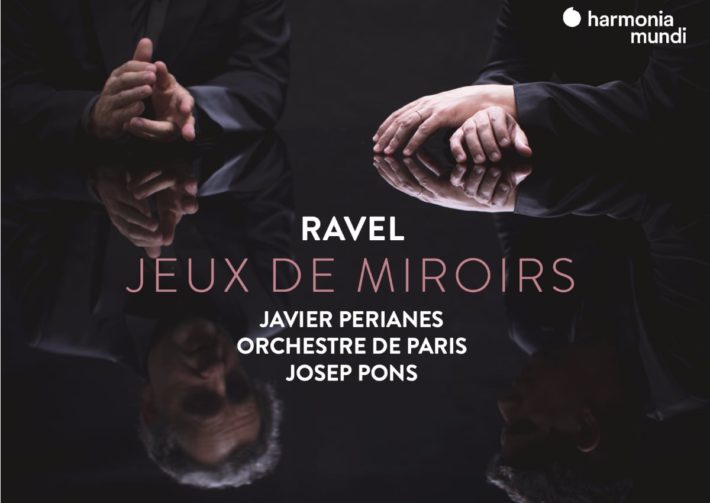Harmonia Mundi’s latest Ravel release programs just three works — two of them in different incarnations. Framing either side of the G major Piano Concerto are instrumental and orchestral versions of “Le Tombeau de Couperin” and “Alborada del gracioso” from “Miroirs”. Josep Pons delights in directing the Orchestre de Paris in the orchestral pieces, whilst Javier Perianes’ piano versions are flavored with a highly distinctive approach.

Opening vividly with the orchestral version of “Alborada”, Pons initially takes a leisure approach before unleashing a sense of fun. This characterful performance grows, portraying the dark moments with an intensity of emotion. The orchestra is captured with clarity and space in the enhancing acoustics of the Philharmonie de Paris; the woodwinds, double reeds especially, have a rich quality, whilst flutes have a breathy tone, creating an intrinsic and authentic timbre. Space around the strings allows a bloom with a resonant bass, whilst a wide stereo perspective gives a sense of proportion.
Encasing the piano concerto are the two versions of “Le Tombeau de Couperin”, the piano version followed by the orchestral version. Perianes’ personal reading forms an overarching structure where individual movements project in a distinctive, but muted and reserved interpretation. Comparison with other rendition can be helpful in examining the pianist’s approach; The “Prelude” is sprightly, with a lyrical approach, compared to Jean-Yves Thibaudet’s more economic use of the pedal, which highlights the brittler, more distinctive textures of the piece and a greater awareness of the imitative Baroque style. Perianes’ “Fugue” is paced well, with a pensive quality and some exquisite pianissimo playing. Benjamin Grosvenor’s rendition (from his ‘Homages’ album for Decca, only on its digital version), despite being more expansive, emphasizes the musical shaping with greater expression.
“Forlane” continues with an aloof character from Perianes, where Thibaudet’s articulation is crisper whilst Bertrand Chamayou brings clarity of tone difficult to surpass. Perianes’ “Rigaudon” is bright, but Chamayou excels most with his polished approach. The emotional heart of the piece is found in the “Menuet”. Here Perianes’ restraint in moderating the music peaks with a genuine regard for Ravel’s tempo markings, while Grosvenor’s has clarity in a refined performance. Although authentic to Ravel’s own recording of “Toccata”, Perianes is a heavyweight who can miss the dexterous virtuosity which can make this finale electrifyingly intense, as shown by the comparable versions.
Arriving at the Piano Concerto, we find Perianes giving a rather leisure performance, rather muted in color. Playing the first movement with a fluid approach to tempo, the ‘bluesy’ moments are stylish and convincing. Whilst there is excitement, Jean-Efflam Bavouzet’s rendition captures greater intensity and awe. Similarly to the “Menuet”, the second movement has a reflective air, but misses the phrasing and direction of either Martha Argerich or Yuja Wang. Perianes’ finale has similar parallels to the finale in his “Le Tombeau”; In Perianes’ hands, whilst an admirable performance, there is again excessive restraint and a loss of transparency, resulting in dense piano textures.
The orchestral playing carries this movement through, especially the woodwind and brass. Perianes’ sound is very mellow, which suits the writing for the lower register, but lacks the clarity of tone in the treble to sparkle. As a comparison, go to Kristian Zimmerman’s celebrated performance, which offers a masterclass in the finale and the work overall. No complaints about the recording engineering though, the piano is appropriately balanced, with a concert-like listening experience.
With greater rhythmic clarity and vitality than Boulez’s, Pons’ orchestral version of “Le Tombeau” is engaging and beautiful, bringing sophistication and movement. It also contrasts starkly with Perianes’ different interpretative choices. Pons orchestral sound is sweet and refined. The tautness and precision of the playing from the Orchestre de Paris are stunning, showcased by the excellent recorded sound. “Prelude” gleams and shimmers translucently, whilst “Forlane” is elegant, refined and sophisticated, swaying gently to capture the essence of the dance.
“Menuet” is brisker than Perianes, whilst the peaks are also moderated and the orchestral colors varied. “Rigaudon” has distinctive layers of sound, again aided by the balanced recording which allows hearing the masterful orchestration layers, creating the finest musical mille-feuille.
Closing the album, Perianes’ “Alborada del gracioso” is consistent with his other interpretations. He is sadly overly reticent to capture the humor or match the vivid spectrum of colors that Pons finds in the orchestral version, which opened the album with such promise.
Ravel – Piano Concerto, Le Tombeau de Couperin, Alborada del gracioso (orchestral and piano versions)
Javier Perianes – Piano
Orchestre de Paris
Josep Pons – Conductor




















